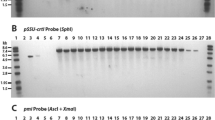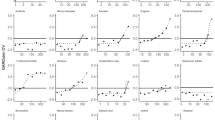Abstract
GM crops have great potential to improve food quality, increase harvest yields and decrease dependency on certain chemical pesticides. Before entering the market their safety needs to be scrutinized. This includes a detailed analysis of allergenic risks, as the safety of allergic consumers has high priority. However, not all tests currently being applied to assessing allergenicity have a sound scientific basis. Recent events with transgenic crops reveal the fallacy of applying such tests to GM crops.
This is a preview of subscription content, access via your institution
Access options
Subscribe to this journal
Receive 12 print issues and online access
$209.00 per year
only $17.42 per issue
Buy this article
- Purchase on Springer Link
- Instant access to full article PDF
Prices may be subject to local taxes which are calculated during checkout

Similar content being viewed by others
References
Codex Alimentarius Commission. Alinorm 03/34: Joint FAO/WHO Food Standard Programme, Codex Alimentarius Commission, Twenty-Fifth Session, Rome, 30 June–5 July, 2003. Appendix III, Guideline for the conduct of food safety assessment of foods derived from recombinant-DNA plants and Appendix IV, Annex on the assessment of possible allergenicity, pp. 47–60 (2003).
Sampson, H.A. Food allergy—accurately identifying clinical reactivity. Allergy 60 S79, 19–24 (2005).
Taylor, S.L. Review of the development of methodology for evaluating the human allergenic potential of novel proteins. Mol. Nutr. Food Res. 50, 604–609 (2006).
Nordlee, J.A., Taylor, S.L., Townsend, J.A., Thomas, J.A. & Bush, R.K. Identification of a Brazil-nut allergen in transgenic soybeans. N. Engl. J. Med. 334, 688–692 (1996).
Metcalfe, D.D. et al. Assessment of the allergenic potential of foods derived from genetically modified crop plants. Crit. Rev. Food Sci. Nutr. 36(S), 165–186 (1996).
FAO/WHO. Evaluation of allergenicity of genetically modified foods. Report of a joint FAO/WHO expert consultation on allergenicity of foods derived from biotechnology. (Food and Agriculture Organization of the United Nations (FAO), Rome, 2001.
Goodman, R.E., Hefle, S.L., Taylor, S.L. & van Ree, R. Assessing genetically modified crops to minimize the risk of increased food allergy: a review. Int. Arch. Allergy Immunol. 137, 153–166 (2005).
Aalberse, R.C. Structural biology of allergens. J. Allergy Clin. Immunol. 106, 228–238 (2000).
Ladics, G.S., Bannon, G.A., Silvanovich, A. & Cressman, R.F. Comparison of conventional FASTA identity searches with the 80 amino acid sliding window FASTA search for elucidation of potential identities to known allergens. Mol. Nutr. Food Res. 51, 985–998 (2007).
Goodman, R.E. & Hefle, S.L. Gaining perspective on the allergenicity assessment of genetically modified crops. Expert Opin. Immunol. 1, 561–578 (2005).
Goodman, R.E. & Wise, J. Predicting the allergenicity of novel proteins in genetically modified organisms. in Food Allergy (eds. Maleki S.J. et al.) 219–247 (American Society of Microbiology Press, Washington, DC, 2006).
Hileman, R.E. et al. Bioinformatic methods for allergenicity assessment using a comprehensive allergen database. Int. Arch. Allergy Immunol. 128, 280–291 (2002).
Stadler, M.B. & Stadler, B.M. Allergenicity prediction by protein sequence. FASEB J. 17, 1141–1143 (2003).
Silvanovich, A. et al. The value of short amino acid sequence matches for prediction of protein allergenicity. Toxicol. Sci. 90, 252–258 (2006).
Sten, E. et al. A comparative study of the allergenic potency of wild-type and glyphosate-tolerant gene-modified soybean cultivars. APMIS 112, 21–28 (2004).
Ladics, G.S., Bardina, L., Cressman, R.F., Mattsson, J.L. & Sampson, H.A. Lack of cross-reactivity between the Bacillus thuringiensis derived protein Cry1F in maize grain and dust mite Der p7 protein with human sera positive for Der p7-IgE. Regul. Toxicol. Pharmacol. 44, 136–143 (2006).
van Ree, R. Carbohydrate epitopes and their relevance for the diagnosis and treatment of allergic disease. Int. Arch. Allergy Immunol. 129, 189–197 (2002).
Altmann, F. The role of protein glycosylation in allergy. Int. Arch. Allergy Immunol. 142, 99–115 (2007).
Asero, R. et al. IgE-mediated food allergy diagnosis: current status and new perspectives. Mol. Nutr. Food Res. 51, 135–147 (2007).
Astwood, J.D., Leach, J.N. & Fuchs, R.L. Stability of food allergens to digestion in vitro. Nat. Biotechnol. 14, 1269–1273 (1996).
Thomas, K. et al. A multi-laboratory evaluation of a common in vitro pepsin digestion assay protocol used in assessing the safety of novel proteins. Regul. Toxicol. Pharmacol. 39, 87–98 (2004).
Asero, R. et al. Lipid transfer protein: a pan-allergen in plant-derived foods that is highly resistant to pepsin digestion. Int. Arch. Allergy Immunol. 122, 20–32 (2000).
Fu, T.J., Abbott, U.R. & Hatzos, C. Digestibility of food allergens and nonallergenic proteins in simulated gastric fluid and simulated intestinal fluid—a comparative study. J. Agric. Food Chem. 50, 7154–7160 (2002).
Yagami, T., Haishima, Y., Nakamura, A., Osuna, H. & Ikezawa, Z. Digestibility of allergens extracted from natural rubber latex and vegetable foods. J. Allergy Clin. Immunol. 106, 752–762 (2000).
Aalberse, R.C. & Stapel, S.O. Structure of food allergens in relation to allergenicity. Pediatr. Allergy Immunol. 12 Suppl 14, 10–14 (2001).
Vassilopoulou, E. et al. Severe immediate allergic reactions to grapes: part of a lipid transfer protein-associated clinical syndrome. Int. Arch. Allergy Immunol. 143, 92–102 (2007).
Pastorello, E.A. et al. Identification of hazelnut major allergens in sensitive patients with positive double-blind, placebo-controlled food challenge results. J. Allergy Clin. Immunol. 109, 563–570 (2002).
Breiteneder, H. & Radauer, C. A classification of plant food allergens. J. Allergy Clin. Immunol. 114, 127–130 (2004).
Untersmayr, E. et al. The effects of gastric digestion on codfish allergenicity. J. Allergy Clin. Immunol. 115, 377–382 (2005).
Bannon, G.A. et al. Digestive stability in the context of assessing the potential allergenicity of food proteins. Comments Toxicol. 8, 271–285 (2002).
Burks, A.W. & Fuchs, R.L. Assessment of the endogenous allergenicity in glyphosate-tolerant and commercial soybean varieties. J. Allergy Clin. Immunol. 96, 1008–1010 (1995).
Lehrer, S.B. & Reese, G. Recombinant proteins in newly developed foods: identification of allergenic activity. Int. Arch. Allergy Immunol. 113, 122–124 (1997).
Gao, Z.S. et al. Genomic cloning and linkage mapping of Mal d 1 (PR-10) gene family in apple (Malus domestica). Theor. Appl. Genet. 111, 171–183 (2005).
Carnes, J., Ferrer, A. & Fernandez-Caldas, E. Allergenicity of 10 different apple varieties. Ann. Allergy Asthma Immunol. 96, 564–570 (2006).
Zuidmeer, L. Allergenicity assessment of apple cultivars: hurdles in quantifying labile fruit allergens. Int. Arch. Allergy Immunol. 141, 230–240 (2006).
Codina, R., Ardusso, L., Lockey, R.F., Crisci, C. & Medina, I. Allergenicity of varieties of soybean. Allergy 58, 1293–1298 (2003).
Sancho, A.I. et al. Maturity and storage influence on the apple (Malus domestica) allergen Mal d 3, a nonspecific lipid transfer protein. J. Agric. Food Chem. 54, 5098–5104 (2006a).
Sancho, A.I. et al. Effect of postharvest storage on the expression of the apple allergen Mal d 1. J. Agric. Food Chem. 54, 5917–5923 (2006b).
Marzban, G. et al. Localization and distribution of the major allergens in apple fruits. Plant Sci. 169, 387–394 (2005).
Jenkins, J.A., Griffiths-Jones, S., Shewry, P.R., Breiteneder, H. & Mills, E.N.C. Structural relatedness of plant food allergens with specific reference to cross-reactive allergens: an in silico analysis. J. Allergy Clin. Immunol. 115, 163–170 (2005).
Ibanez, M.D., Marinez, M., Sanchez, J.J. & Fernandez-Caldas, E. Legume cross-reactivity (in Spanish). Allergol. Immunopathol. (Madr.) 31, 151–161 (2003).
Bindslev-Jensen, C., et al. Assessment of the potential allergenicity of ice structuring protein type III HPLC 12 using the FAO/WHO 2001 decision tree for novel foods. Food Chem. Toxicol. 41, 81–87 (2003).
Ferriera, F., Hawranek, T., Gruber, P., Wopfner, N. & Mari, A. Allergic cross-reactivity: from gene to the clinic. Allergy 59, 243–267 (2004).
Dearman, R.J. & Kimber, I. A mouse model for food allergy using intraperitoneal sensitization. Methods 41, 91–98 (2007).
McClain, S. & Bannon, G.A. Animal models of food allergy: opportunities and barriers. Curr. Allergy Asthma Rep. 6, 141–144 (2006).
Matsuda, T., Matsubara, T. & Hino, S. Immunogenic and allergenic potentials of natural and recombinant innocuous proteins. J. Biosci. Bioeng. 101, 203–211 (2006).
Perzanowski, M.S., Ronmark, E., Nold, B., Lundback, B. & Platts-Mills, T.A. Relevance of allergens from cats and dogs to asthma in the northernmost province of Sweden: schools as a major site of exposure. J. Allergy Clin. Immunol. 103, 1018–1024 (1999).
Fernandez-Rivas, M. et al. Apple allergy across Europe: how allergen sensitization profiles determine the clinical expression of allergies to plant foods. J. Allergy Clin. Immunol. 118, 481–488 (2006).
Reuter, A. et al. A critical assessment of allergen component-based in vitro diagnosis in cherry allergy across Europe. Clin. Exp. Allergy 36, 815–823 (2006).
Herouet, C. et al. Safety evaluation of the phosphinothricin acetyltransferase proteins encoded by the pat and bar sequences that confer tolerance to glufosinate-ammonium herbicide in transgenic plants. Regul. Toxicol. Pharmacol. 41, 134–149 (2005).
Jones, S.M., Magnolfi, C.F., Cooke, S.K. & Sampson, H.A. Immunologic cross-reactivity among cereal grains and grasses in children with food hypersensitivity. J. Allergy Clin. Immunol. 96, 341–351 (1995).
Ikematsu, K., Tachimoto, H., Sugiasaki, C., Syukuya, A. & Ebisawa, M. Feature of food allergy developed during infancy (1)—relationship between infantile atopic dermatitis and food allergy (in Japanese). Arerugi 55, 140–150 (2006).
Morton, R.L. et al. Bean alpha-amylase inhibitor 1 in transgenic peas (Pisum sativum) provides complete protection from pea weevil (Bruchus pisorum) under field conditions. Proc. Natl. Acad. Sci. USA 97, 3820–3825 (2000).
Prescott, V.E. et al. Transgenic expression of bean alpha-amylase inhibitor in peas results in altered structure and immunogenicity. J. Agric. Food Chem. 53, 9023–9030 (2005).
Editorial. Genetically modified mush. Nat. Biotechnol. 24, 2 (2006).
Sinagawa-Garcia, S.R. et al. Safety assessment by in vitro digestibility and allergenicity of genetically modified maize with Amaranth 11S globulin. J. Agric. Food Chem. 52, 2709–2714 (2004).
Acknowledgements
The preparation of this article was conducted with a contribution of the University of Nebraska Agricultural Research Division, supported in part by funds provided through the US Department of Agriculture. Additional support was provided by the Food Allergy Research and Resource Program. Mention of a trade name, proprietary products or company name is for presentation clarity and does not imply endorsement by the authors. R.E.G. acknowledges Bayer CropScience for providing funds to support research for evaluating methods to compare endogenous allergenicity of crop varieties through research at the University of Nebraska. S.V. acknowledges Monsanto Company for supporting studies on the bio-variability of the allergenic potential of soybean varieties in comparison to transgenic lines.
Author information
Authors and Affiliations
Corresponding author
Ethics declarations
Competing interests
Authors affiliated with the University of Nebraska declare that six international biotechnology companies (BASF, Bayer CropScience, Dow AgroSciences, DuPont/Pioneer, Monsanto Company and Syngenta CropProtection) cosponsor the AllergenOnline database, which was developed and is maintained at the University of Nebraska.
Rights and permissions
About this article
Cite this article
Goodman, R., Vieths, S., Sampson, H. et al. Allergenicity assessment of genetically modified crops—what makes sense?. Nat Biotechnol 26, 73–81 (2008). https://doi.org/10.1038/nbt1343
Published:
Issue Date:
DOI: https://doi.org/10.1038/nbt1343
This article is cited by
-
Bioinformatic and literature assessment of toxicity and allergenicity of a CRISPR-Cas9 engineered gene drive to control Anopheles gambiae the mosquito vector of human malaria
Malaria Journal (2023)
-
Protein familiarity is a fundamental but rarely operationalized concept in the safety assessment of genetically modified crops: example of phosphomannose isomerase (PMI)
Transgenic Research (2023)
-
Protease resistance of food proteins: a mixed picture for predicting allergenicity but a useful tool for assessing exposure
Clinical and Translational Allergy (2018)
-
Definition and design of hypoallergenic foods
Allergo Journal International (2015)



